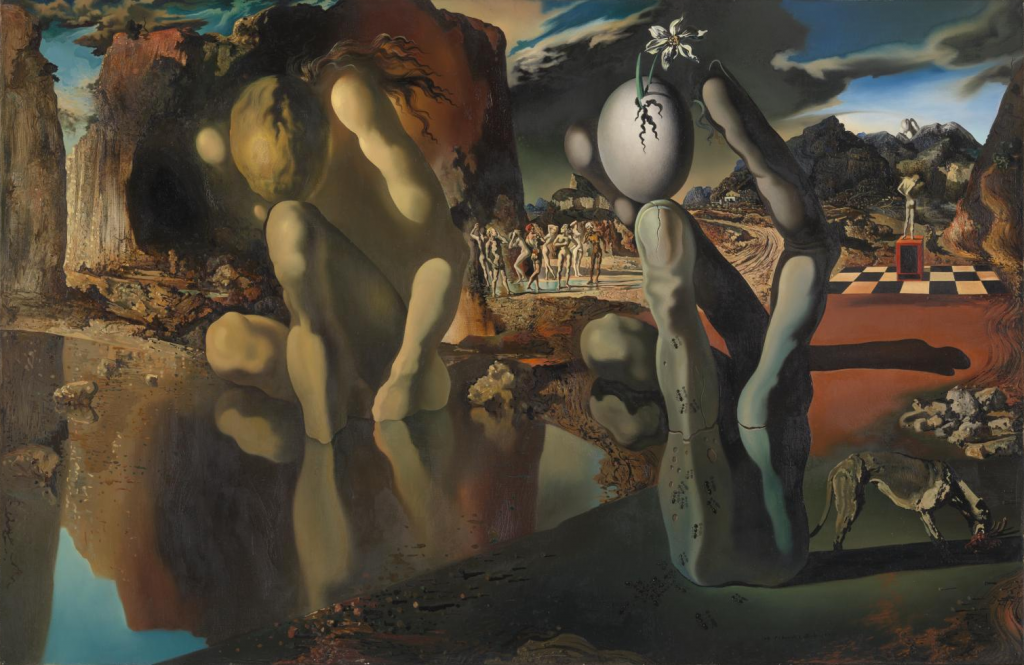According to Greek mythology, Narcissus fell in love with his own reflection in a pool. Unable to embrace the watery image, he pined away, and the gods immortalised him as a flower. Dalí shows this metamorphosis by doubling a crouching figure by the lake with a hand clutching an egg, from which the narcissus flower sprouts. When this painting was first exhibited it was accompanied by a long poem by Dalí. Together, the words and image suggest a range of emotions triggered by the theme of metamorphosis, including anxiety, disgust and desire.
Gallery label, October 2016

Salvador Dalí 1904–1989, Metamorphosis of Narcissus, Métamorphose de Narcisse, 1937, Oil paint on canvas, 510 × 780 mm
According to Greek mythology, Narcissus fell in love with his own reflection in a pool. Unable to embrace the watery image, he pined away, and the gods immortalised him as a flower. Dalí shows this metamorphosis by doubling a crouching figure by the lake with a hand clutching an egg, from which the narcissus flower sprouts. When this painting was first exhibited it was accompanied by a long poem by Dalí. Together, the words and image suggest a range of emotions triggered by the theme of metamorphosis, including anxiety, disgust and desire.
Gallery label, October 2016
This painting is Dalí’s interpretation of the Greek myth of Narcissus. Narcissus was a youth of great beauty who loved only himself and broke the hearts of many lovers. The gods punished him by letting him see his own reflection in a pool. He fell in love with it, but discovered he could not embrace it and died of frustration. Relenting, the gods immortalised him as the narcissus (daffodil) flower. For this picture Dalí used a meticulous technique which he described as ‘hand-painted colour photography’ to depict with hallucinatory effect the transformation of Narcissus, kneeling in the pool, into the hand holding the egg and flower. Narcissus as he was before his transformation is seen posing in the background. The play with ‘double images’ sprang from Dalí’s fascination with hallucination and delusion.
This was Dalí’s first painting to be made entirely in accordance with the paranoiac critical method, which the artist described as a ‘Spontaneous method of irrational knowledge, based on the critical-interpretative association of the phenomena of delirium’ (The Conquest of the Irrational, published in The Secret Life of Salvador Dalí, New York 1942). Robert Descharnes noted that this painting meant a great deal to Dalí, as it was the first Surrealist work to offer a consistent interpretation of an irrational subject.
The artist said to Descharnes of this picture:
- A painting shown and explained to Dr. Freud.
- Pedagogical presentation of the myth of narcissism, illustrated by a poem written at the same time.
In this poem and this painting, there is death and fossilization of Narcissus.
The poem to which Dalí referred was published in 1937, in a small book by the artist entitled Metamorphosis of Narcissus. The book also contains two explanatory notes printed facing a colour reproduction of the painting, the first of which reads:
“WAY OF VISUALLY OBSERVING THE COURSE OF THE METAMORPHOSIS OF NARCISSUS REPRESENTED IN THE PRINT ON THE OPPOSITE PAGE:
“If one looks for some time, from a slight distance and with a certain ‘distant fixedness’, at the hypnotically immobile figure of Narcissus, it gradually disappears until at last it is completely invisible.
“The metamorphosis of the myth takes place at that precise moment, for the image of Narcissus is suddenly transformed into the image of a hand which rises out of his own reflection. At the tips of its fingers the hand is holding an egg, a seed, a bulb from which will be born the new narcissus – the flower. Beside it can be seen the limestone sculpture of the hand – the fossil hand of the water holding the blown flower.”
When he met Sigmund Freud in London in 1938, Dalí took this picture with him as an example of his work, as well as a magazine containing an article he had written on paranoia. Freud wrote the following day to Stefan Zweig, who had introduced them, that ‘it would be very interesting to explore analytically the growth of a picture like this’.
Terry Riggs
March 1998
Source: Tate







